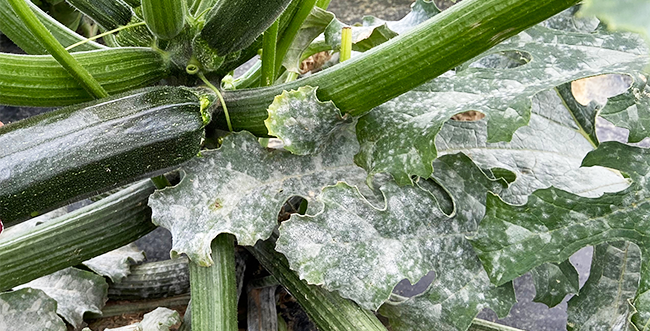Like all plants, cucurbits are not immune to disease. See below for tips on both preventing and treating some of the most common diseases.
Good maintenance is key in preventing disease: anthracnose, powdery mildew and downy mildew are the most common. Watchwords: observe, identify, prevent, and control!
 Anthracnose
Anthracnose
Leaf-spot disease caused by a fungus.
Signs
- Brown spots with black margins on leaves.
- Leaves eventually wither, tun brown and drop off.
Prevention and control
- Opt for resistant varieties.
- Do not water at the end of the day, particularly during hot, humid weather.
- Cut and remove infected plants. Do not compost them.
- Do not save seeds from infected plants.
- Clean and disinfect tools.
- Spray plants with a fungicide during rainy periods for both prevention and control.
 Powdery mildew
Powdery mildew
A common fungal disease. Most cucurbit crops are susceptible.
Signs
- White powdery spots on the top sides of leaves or on plant stems. Eventually, the entire plant will be covered so that leaves look like they've been dusted with talcum powder.
- When severe, leaves turn yellow and twisted.
- Infected stems break and drop.
Prevention and control
- Opt for varieties resistant to powdery mildew, and plant in full sun.
- Ensure good air circulation between plants; crowded plants with poor air circulation are more likely to be infected.
- Water on a regular basis.
- Cut and collect infected plants. Do not compost.
- Spray both sides of leaves with a fungicide.
- Spray leaves in dry weather with a baking soda solution (dissolve 1 Tablespoon baking soda in 1 L of water). Repeat every 14 days. Also effective: mix 1 part milk with 3 parts water then spray. Both sprays will slow down development or help prevent the disease from appearing.
 Downy mildew
Downy mildew
Disease caused by a fungus which spreads rapidly over foliage and shows 4 to 12 days after infection. All cucurbits can be affected, but it is mostly destructive in cucumbers and melons.
Signs
Pale green to yellow spots appear on the upper surfaces of leaves and later turn brown. Spots are angular in shape and bordered by leaf veins. Leaf spots grow together and the entire leaf becomes brown.
Prevention and control
- Opt for resistant varieties and plant in full sun.
- Ensure plenty of air circulation between plants.
- Water in the morning, avoiding foliage.
- Cut and collect affected plants. Do not compost.
- Spray plants with a preventative fungicide, or as soon as symptoms appear.
- Spray leaves in dry weather with a baking soda solution (dissolve 1 Tablespoon baking soda in 1 L of water).




